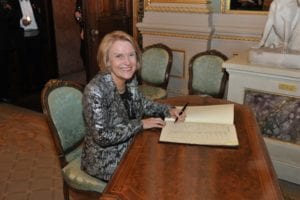Allyson Lawless, SAICE’s president in 2000, was made an International Fellow of the Royal Academy of Engineering, at a glittering function in Drapers Hall, London, on 5 November 2012.
The Royal Academy of Engineering (RAE) was founded by HRH the Duke of Edinburgh in 1976 to promote engineering and technological development, provide independent and impartial advice to government, work to secure the next generation of engineers, and provide a voice for Britain’s engineering community. The RAE scope has since extended to supporting engineering and technology development, and the development of the engineering profession in emerging nations. Academy Fellows are drawn from the UK’s most eminent engineers and international specialists representing the best of engineering worldwide. Their role is to provide leadership and expertise to address the relationships between engineering, technology, and the quality of life. Academy activities are grounded in a vision that engineers have essential roles to play in addressing the world’s most pressing challenges, including climate change, global poverty and international security. SAICE is very happy to report that Allyson was one of four International Fellows to be inducted on 5 November. The citation revolved around breaking the mould in a male dominated world and her pioneering skills development work. Over the years Allyson has developed close relationships with many government departments and has represented the voice of civil engineering and SAICE on many fora. Most engineers are familiar with Allyson’s ground-breaking Numbers and Needs books in which she initially researched the skills challenges associated with civil engineering, and then studied the local government civil engineering challenges in depth. Emerging from these findings she has initiated many mentoring programmes in government and more recently in the private sector and is currently campaigning to have the candidate phase of engineering training recognised as a formal training phase, equivalent to that of apprenticeships for artisans. Allyson is currently advising on the development of the skills plan for the Strategic Infrastructure Projects (SIPs). The other three International Fellows who shared the honour with her on the day were:Shirley Anne Jackson, the first woman and the first African American to serve as chair of the U.S. Nuclear Regulatory Commission, and who is now a member of President Obama’s Council of Advisers on Science and Technology.
Michel Virlogeux, the talented bridge designer responsible for the construction of the iconic Normandy Bridge, and the Millau Viaduct (the world’s longest bridge at this altitude – 343 metres). Dr Virlogeux has designed over 100 of his native France’s most beloved bridges, and many further afield.
Tony Gibbs, a pioneer in promoting safe architectural and engineering designs, particularly health care buidlings that can withstand earthquakes and hurricanes. He has been recognised by the United Nations for his contribution to disaster risk reduction in the Caribbean and throughout the Americas. Allyson reports having had a wonderful day, which included attending a briefing at which Fellows showcased their pioneering work. She was particularly thrilled to have met Dr Stephen Myers, the Director of Accelerators and Technology in Geneva, the body which recently announced finding the Higgs boson, which explains why objects in our universe have mass. She was also impressed with Suranga Chandratillake, an unassuming young man who has created the world’s premier video search company, Blinkx, valued at £500 million, before his 35th birthday! Of interest was meeting Sir John Beddington, who as the Government Chief Scientific Advisor, reports directly to the Prime Minister and Cabinet Secretary on matters of science and engineering. Every government department has a Chief Scientific Adviser (CSA) who as a network collaborates to ensure that science and engineering are at the core of decisions within departments and across government. According to Allyson the evening’s event represented a who’s who in engineering. She was inspired by the number of professors, engineers, scientists, Sirs and Lords who had made a significant contribution to engineering over the years, both in the UK and further afield. Her only regret was that the Senior Fellow of the RAE, Prince Philip, was not well enough to attend!





